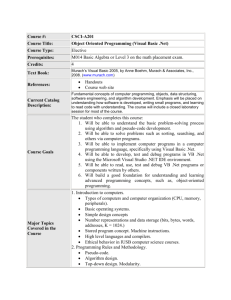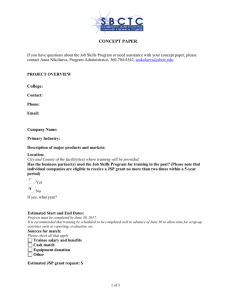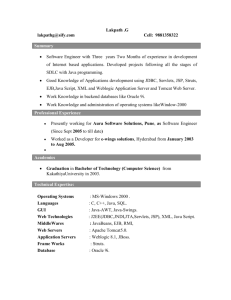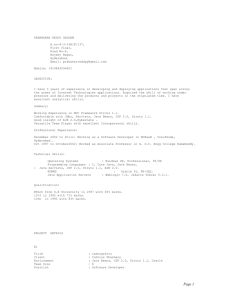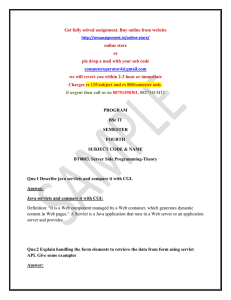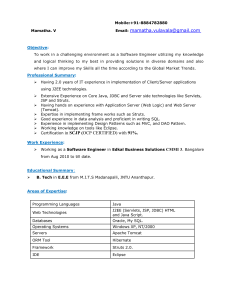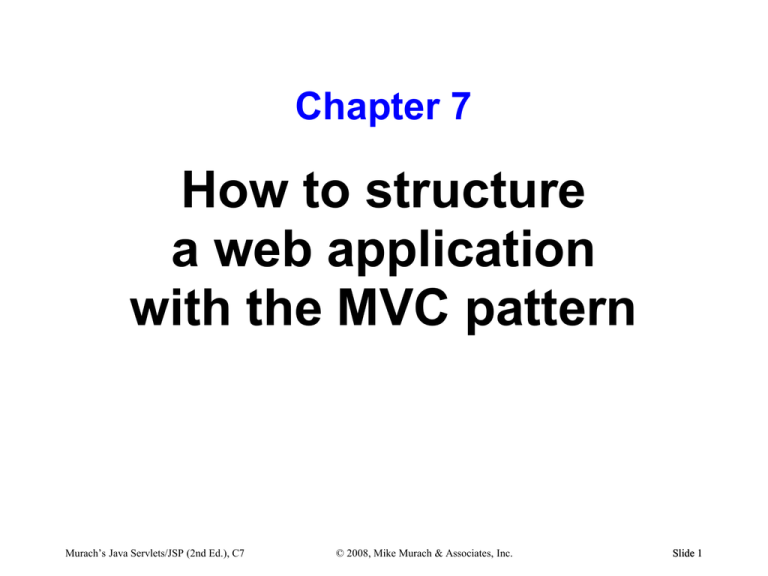
Chapter 7
How to structure
a web application
with the MVC pattern
Murach’s Java Servlets/JSP (2nd Ed.), C7
© 2008, Mike Murach & Associates, Inc.
Slide 1
Objectives
Applied
Use the MVC pattern to develop your web applications so servlets
control the processing and JSPs do the presentation.
Provide for server-side data validation in your applications.
Use include files in your JSPs at compile-time or runtime.
Use the web.xml file to set initialization parameters and use your
servlets to get the parameters.
Use the web.xml file to implement custom error handling.
Murach’s Java Servlets/JSP (2nd Ed.), C7
© 2008, Mike Murach & Associates, Inc.
Slide 2
Objectives (cont.)
Knowledge
Describe the Model 1 architecture.
Describe the Model-View-Controller pattern
Explain how the MVC pattern can improve application
development.
Distinguish between the use of JavaScript and servlets for data
validation.
Describe the use of include files.
Murach’s Java Servlets/JSP (2nd Ed.), C7
© 2008, Mike Murach & Associates, Inc.
Slide 3
The code for the servlet
package email;
import
import
import
import
import
java.io.*;
javax.servlet.*;
javax.servlet.http.*;
business.User;
data.UserIO;
public class AddToEmailListServlet extends HttpServlet
{
protected void doPost(HttpServletRequest request,
HttpServletResponse response)
throws ServletException,
IOException
{
// get parameters from the request
String firstName =
request.getParameter("firstName");
String lastName = request.getParameter("lastName");
String emailAddress =
request.getParameter("emailAddress");
Murach’s Java Servlets/JSP (2nd Ed.), C7
© 2008, Mike Murach & Associates, Inc.
Slide 4
The code for the servlet (cont.)
// get a relative file name
ServletContext context = getServletContext();
String path =
context.getRealPath("/WEB-INF/EmailList.txt");
// use regular Java classes
User user = new User(firstName, lastName,
emailAddress);
UserIO.addRecord(user, path);
// store the User object in the request object
request.setAttribute("user", user);
// forward request and response objects to JSP page
String url = "/display_email_entry.jsp";
RequestDispatcher dispatcher =
getServletContext().getRequestDispatcher(url);
dispatcher.forward(request, response);
}
}
Murach’s Java Servlets/JSP (2nd Ed.), C7
© 2008, Mike Murach & Associates, Inc.
Slide 5
The code for the JSP
<!DOCTYPE HTML PUBLIC
"-//W3C//DTD HTML 4.01 Transitional//EN"
"http://www.w3.org/TR/html4/loose.dtd">
<html>
<head>
<title>Murach's Java Servlets and JSP</title>
</head>
<body>
<h1>Thanks for joining our email list</h1>
<p>Here is the information that you entered:</p>
<%@ page import="business.User" %>
<% User user = (User) request.getAttribute("user"); %>
<table cellspacing="5" cellpadding="5" border="1">
<tr>
<td align="right">First name:</td>
<td><%= user.getFirstName() %></td>
</tr>
Murach’s Java Servlets/JSP (2nd Ed.), C7
© 2008, Mike Murach & Associates, Inc.
Slide 6
The code for the JSP (cont.)
<tr>
<td align="right">Last name:</td>
<td><%= user.getLastName() %></td>
</tr>
<tr>
<td align="right">Email address:</td>
<td><%= user.getEmailAddress() %></td>
</tr>
</table>
<p>To enter another email address, click on the Back <br>
button in your browser or the Return button shown <br>
below.</p>
<form action="join_email_list.html" method="post">
<input type="submit" value="Return">
</form>
</body>
</html>
Murach’s Java Servlets/JSP (2nd Ed.), C7
© 2008, Mike Murach & Associates, Inc.
Slide 7
The Model 1 architecture
Browser
HTTP request
HTTP response
JSP
display_email_entry.jsp
Java classes
User.class
UserIO.class
Murach’s Java Servlets/JSP (2nd Ed.), C7
Data store
© 2008, Mike Murach & Associates, Inc.
Slide 8
The Model 1 architecture
The Model 1 architecture is sometimes adequate for web
applications with limited processing requirements. With this
architecture, JSPs handle all of the processing and presentation for
the application.
In the Model 1 architecture, the JSPs can use regular Java classes
to store the data of the application and to do the business
processing of the application.
The data store can be a database or one or more disk files. This is
often referred to as persistent data storage because it exists after
the application ends.
Murach’s Java Servlets/JSP (2nd Ed.), C7
© 2008, Mike Murach & Associates, Inc.
Slide 9
The Model-View-Controller pattern
Browser
HTTP response
HTTP request
Controller
AddToEmailListServlet.class
View
show_email_entry.jsp
Model
User.class
UserIO.class
Data store
Murach’s Java Servlets/JSP (2nd Ed.), C7
© 2008, Mike Murach & Associates, Inc.
Slide 10
The Model-View-Controller (MVC) pattern
The Model-View-Controller (MVC) pattern is commonly used to
structure web applications that have significant processing
requirements. That makes them easier to code and maintain. This
pattern is also known as the Model 2 architecture.
In the MVC pattern, the model consists of business objects like the
User object, the view consists of HTML pages and JSPs, and the
controller consists of servlets.
Usually, the methods of data classes like the UserIO class are used
to read and write business objects like the User object to and from
the data store.
When you use the MVC pattern, you try to construct each layer so
it’s as independent as possible. Then, if you need to make changes
to one layer, any changes to the other layers are minimized.
Murach’s Java Servlets/JSP (2nd Ed.), C7
© 2008, Mike Murach & Associates, Inc.
Slide 11
Two methods available from the request object
Method
setAttribute(String name, Object o)
getAttribute(String name)
Murach’s Java Servlets/JSP (2nd Ed.), C7
Description
Stores any object in the request
as an attribute and specifies a
name for the attribute.
Attributes are reset between
requests.
Returns the value of the
specified attribute as an Object
type. If no attribute exists for
the specified name, this
method returns a null value.
© 2008, Mike Murach & Associates, Inc.
Slide 12
How to set a request attribute
User user = new User(firstName, lastName, emailAddress);
request.setAttribute("user", user);
How to get a request attribute
User user = (User) request.getAttribute("user");
How to set a request attribute for a primitive type
int id = 1;
request.setAttribute("id", id);
How to get a request attribute for a primitive type
int id = (Integer) request.getAttribute("id");
Murach’s Java Servlets/JSP (2nd Ed.), C7
© 2008, Mike Murach & Associates, Inc.
Slide 13
A method of the ServletContext object for working
with paths
Method
getRequestDispatcher(String path)
Description
Returns a RequestDispatcher
object for the specified path.
A method of the RequestDispatcher object
Method
forward(ServletRequest request,
ServletResponse response)
Murach’s Java Servlets/JSP (2nd Ed.), C7
Description
Forwards the request and
response objects to another
resource on the server
(usually a JSP or servlet).
© 2008, Mike Murach & Associates, Inc.
Slide 14
How to forward the request to an HTML page
String url = "/display_email_entry.html";
RequestDispatcher dispatcher =
getServletContext().getRequestDispatcher(url);
dispatcher.forward(request, response);
How to forward the request to a JSP
String url = "/display_email_entry.jsp";
RequestDispatcher dispatcher =
getServletContext().getRequestDispatcher(url);
dispatcher.forward(request, response);
How to forward the request to a servlet
String url = "/cart/displayInvoice";
RequestDispatcher dispatcher =
getServletContext().getRequestDispatcher(url);
dispatcher.forward(request, response);
Murach’s Java Servlets/JSP (2nd Ed.), C7
© 2008, Mike Murach & Associates, Inc.
Slide 15
A method of the HttpServletResponse class
Method
sendRedirect(String path)
Murach’s Java Servlets/JSP (2nd Ed.), C7
Description
Sends a temporary redirect response
to the client using the specified
redirect location URL.
© 2008, Mike Murach & Associates, Inc.
Slide 16
How to redirect a response relative to the current
directory
response.sendRedirect("join_email_list.html");
How to redirect a response relative to the servlet
engine
response.sendRedirect(
"/musicStore/email/join_email_list.jsp");
How to redirect a response to a different web
server
response.sendRedirect("http://www.murach.com/email/");
Murach’s Java Servlets/JSP (2nd Ed.), C7
© 2008, Mike Murach & Associates, Inc.
Slide 17
The JavaScript that validates a form
<script language="JavaScript">
function validate(form)
{
if (form.firstName.value=="")
{
alert("Please fill in your first name");
form.firstName.focus();
}
else if (form.lastName.value=="")
{
alert("Please fill in your last name");
form.lastName.focus();
}
else if (form.emailAddress.value=="")
{
alert("Please fill in your email address");
form.emailAddress.focus();
}
Murach’s Java Servlets/JSP (2nd Ed.), C7
© 2008, Mike Murach & Associates, Inc.
Slide 18
The JavaScript that validates a form (cont.)
else
{
form.submit();
}
}
</script>
Murach’s Java Servlets/JSP (2nd Ed.), C7
© 2008, Mike Murach & Associates, Inc.
Slide 19
The HTML for the form
<form action="addToEmailList" method="post">
<table cellspacing="5" border="0">
<tr>
<td align="right">First name:</td>
<td><input type="text" name="firstName"
value="<%= user.getFirstName() %>"></td>
</tr>
<tr>
<td align="right">Last name:</td>
<td><input type="text" name="lastName"
value="<%= user.getLastName() %>"></td>
</tr>
<tr>
<td align="right">Email address:</td>
<td><input type="text" name="emailAddress"
value="<%= user.getEmailAddress() %>"></td>
</tr>
Murach’s Java Servlets/JSP (2nd Ed.), C7
© 2008, Mike Murach & Associates, Inc.
Slide 20
The HTML for the form (cont.)
<tr>
<td></td>
<td><br><input type="button" value="Submit"
onClick="validate(this.form)"></td>
</tr>
</table>
</form>
Murach’s Java Servlets/JSP (2nd Ed.), C7
© 2008, Mike Murach & Associates, Inc.
Slide 21
The dialog box that’s displayed when an entry isn’t
made
Murach’s Java Servlets/JSP (2nd Ed.), C7
© 2008, Mike Murach & Associates, Inc.
Slide 22
How to use JavaScript to validate the data on the
client
When you use JavaScript to display validation messages, they
appear in standard dialog boxes.
If you want to display error messages in an HTML page or JSP,
you can use servlets to validate data on the server side.
Murach’s Java Servlets/JSP (2nd Ed.), C7
© 2008, Mike Murach & Associates, Inc.
Slide 23
A servlet that validates data
package email;
import java.io.*;
import javax.servlet.*;
import javax.servlet.http.*;
import business.User;
import data.UserIO;
public class AddToEmailListServlet extends HttpServlet
{
protected void doPost(HttpServletRequest request,
HttpServletResponse response)
throws ServletException, IOException
{
// get parameters from the form
String firstName =
request.getParameter("firstName");
String lastName = request.getParameter("lastName");
String emailAddress =
request.getParameter("emailAddress");
Murach’s Java Servlets/JSP (2nd Ed.), C7
© 2008, Mike Murach & Associates, Inc.
Slide 24
A servlet that validates data (cont.)
// create the User object from the parameters
User user =
new User(firstName, lastName, emailAddress);
// validate the parameters
String message = "";
String url = "";
if (firstName.length() == 0 ||
lastName.length() == 0 ||
emailAddress.length() == 0)
{
message =
"Please fill out all three text boxes.";
url = "/join_email_list.jsp";
}
else
{
message = "";
Murach’s Java Servlets/JSP (2nd Ed.), C7
© 2008, Mike Murach & Associates, Inc.
Slide 25
A servlet that validates data (cont.)
ServletContext context = getServletContext();
String path = context.getRealPath(
"/WEB-INF/EmailList.txt");
UserIO.addRecord(user, path);
url = "/display_email_entry.jsp";
}
request.setAttribute("user", user);
request.setAttribute("message", message);
// forward request and response to the view
RequestDispatcher dispatcher =
getServletContext().getRequestDispatcher(url);
dispatcher.forward(request, response);
}
}
Murach’s Java Servlets/JSP (2nd Ed.), C7
© 2008, Mike Murach & Associates, Inc.
Slide 26
A JSP that displays a validation message
<!DOCTYPE HTML PUBLIC
"-//W3C//DTD HTML 4.01 Transitional//EN"
"http://www.w3.org/TR/html4/loose.dtd">
<html>
<head>
<title>Murach's Java Servlets and JSP</title>
</head>
<body>
<%@ page import="business.User" %>
<%
// get attributes from the request
User user = (User) request.getAttribute("user");
String message =
(String) request.getAttribute("message");
// handle null values
if (user == null) user = new User();
if (message == null) message = "";
%>
Murach’s Java Servlets/JSP (2nd Ed.), C7
© 2008, Mike Murach & Associates, Inc.
Slide 27
A JSP that displays a validation message (cont.)
<h1>Join our email list</h1>
<p>To join our email list, enter your name and
email address below. <br>
Then, click on the Submit button.</p>
<p><i><%= message %></i></p>
<form action="addToEmailList" method="post">
<table cellspacing="5" border="0">
<tr>
<td align="right">First name:</td>
<td><input type="text" name="firstName"
value="<%= user.getFirstName() %>"></td>
</tr>
<tr>
<td align="right">Last name:</td>
<td><input type="text" name="lastName"
value="<%= user.getLastName() %>"></td>
</tr>
Murach’s Java Servlets/JSP (2nd Ed.), C7
© 2008, Mike Murach & Associates, Inc.
Slide 28
A JSP that displays a validation message (cont.)
<tr>
<td align="right">Email address:</td>
<td><input type="text" name="emailAddress"
value="<%= user.getEmailAddress() %>"></td>
</tr>
<tr>
<td></td>
<td><br><input type="submit" value="Submit"></td>
</tr>
</table>
</form>
</body>
</html>
Murach’s Java Servlets/JSP (2nd Ed.), C7
© 2008, Mike Murach & Associates, Inc.
Slide 29
The JSP that’s displayed when the application is
first started
Murach’s Java Servlets/JSP (2nd Ed.), C7
© 2008, Mike Murach & Associates, Inc.
Slide 30
The JSP that’s displayed when an entry isn’t made
Murach’s Java Servlets/JSP (2nd Ed.), C7
© 2008, Mike Murach & Associates, Inc.
Slide 31
A header file named header.html
<!DOCTYPE HTML PUBLIC
"-//W3C//DTD HTML 4.01 Transitional//EN"
"http://www.w3.org/TR/html4/loose.dtd">
<html>
<head>
<title>Murach's Java Servlets and JSP</title>
</head>
<body>
Murach’s Java Servlets/JSP (2nd Ed.), C7
© 2008, Mike Murach & Associates, Inc.
Slide 32
A footer file named footer.jsp
<%@ page import="java.util.*" %>
<%
// initialize the current year that's used in the
// copyright notice
GregorianCalendar currentDate = new GregorianCalendar();
int currentYear = currentDate.get(Calendar.YEAR);
%>
<p><small>
&copy; Copyright <%= currentYear %>
Mike Murach &amp; Associates, Inc.
All rights reserved
</small></p>
</body>
</html>
Murach’s Java Servlets/JSP (2nd Ed.), C7
© 2008, Mike Murach & Associates, Inc.
Slide 33
A JSP file that uses both include files
<%@ include file="/includes/header.html" %>
<h1>Thanks for joining our email list</h1>
<p>Here is the information that you entered:</p>
<%@ page import="business.User" %>
<% User user = (User) request.getAttribute("user"); %>
<table cellspacing="5" cellpadding="5" border="1">
<tr><td align="right">First name:</td>
<td><%= user.getFirstName() %></td>
</tr>
<tr><td align="right">Last name:</td>
<td><%= user.getLastName() %></td>
</tr>
<tr><td align="right">Email address:</td>
<td><%= user.getEmailAddress() %></td>
</tr>
</table>
Murach’s Java Servlets/JSP (2nd Ed.), C7
© 2008, Mike Murach & Associates, Inc.
Slide 34
A JSP file that uses both include files (cont.)
<p>To enter another email address, click on the Back <br>
button in your browser or the Return button shown <br>
below.</p>
<form action="join_email_list.jsp" method="post">
<input type="submit" value="Return">
</form>
<%@ include file="/includes/footer.jsp" %>
Murach’s Java Servlets/JSP (2nd Ed.), C7
© 2008, Mike Murach & Associates, Inc.
Slide 35
The JSP page
Murach’s Java Servlets/JSP (2nd Ed.), C7
© 2008, Mike Murach & Associates, Inc.
Slide 36
Another JSP page that uses the same header and
footer
Murach’s Java Servlets/JSP (2nd Ed.), C7
© 2008, Mike Murach & Associates, Inc.
Slide 37
How to include a file in a JSP at compile-time with
an include directive
Syntax
<%@ include file="fileLocationAndName" %>
Examples
<%@ include file="/includes/header.html" %>
<%@ include file="/includes/footer.jsp" %>
How to include a file in a JSP at runtime with an
include action
Syntax
<jsp:include page="fileLocationAndName" />
Examples
<jsp:include page="/includes/header.html" />
<jsp:include page="/includes/footer.jsp" />
Murach’s Java Servlets/JSP (2nd Ed.), C7
© 2008, Mike Murach & Associates, Inc.
Slide 38
Two techniques for including files in a JSP
To include a file in a JSP at compile-time, you use the include
directive.
When you use the include directive, the code in the included file
becomes part of the generated servlet. As a result, any changes to
the included file won’t appear in the JSP until the JSP is
regenerated and recompiled. However, some of the newer web
servers automatically detect changes to included files and
automatically regenerate and recompile the servlets for the JSPs
that need to be updated.
To include a file in a JSP at runtime, you use the include action.
When you use the include action, the generated servlet uses a
runtime call to get the included file, and any changes to the
included file appear in the JSP the next time it is requested.
Murach’s Java Servlets/JSP (2nd Ed.), C7
© 2008, Mike Murach & Associates, Inc.
Slide 39
The web.xml file for the Email List application
<?xml version="1.0" encoding="UTF-8"?><web-app version="2.5"
xmlns="http://java.sun.com/xml/ns/javaee"
xmlns:xsi="http://www.w3.org/2001/XMLSchema-instance"
xsi:schemaLocation="http://java.sun.com/xml/ns/javaee
http://java.sun.com/xml/ns/javaee/web-app_2_5.xsd">
<context-param>
<param-name>custServEmail</param-name>
<param-value>custserv@murach.com</param-value>
</context-param>
<servlet>
<servlet-name>AddToEmailListServlet</servlet-name>
<servlet-class>email.AddToEmailListServlet
</servlet-class>
<init-param>
<param-name>relativePathToFile</param-name>
<param-value>/WEB-INF/EmailList.txt
</param-value>
</init-param>
</servlet>
Murach’s Java Servlets/JSP (2nd Ed.), C7
© 2008, Mike Murach & Associates, Inc.
Slide 40
The web.xml file for the Email List application
(cont.)
<servlet-mapping>
<servlet-name>AddToEmailListServlet</servlet-name>
<url-pattern>/addToEmailList</url-pattern>
</servlet-mapping>
<!-- you can comment out these tags when the app is in
development -->
<error-page>
<error-code>404</error-code>
<location>/error_404.jsp</location>
</error-page>
<error-page>
<exception-type>java.lang.Throwable</exception-type>
<location>/error_java.jsp</location>
</error-page>
Murach’s Java Servlets/JSP (2nd Ed.), C7
© 2008, Mike Murach & Associates, Inc.
Slide 41
The web.xml file for the Email List application
(cont.)
<session-config>
<session-timeout>30</session-timeout>
</session-config>
<welcome-file-list>
<welcome-file>join_email_list.jsp</welcome-file>
</welcome-file-list>
</web-app>
Murach’s Java Servlets/JSP (2nd Ed.), C7
© 2008, Mike Murach & Associates, Inc.
Slide 42
How to work with the web.xml file
The web.xml file is stored in the WEB-INF directory for an
application. When Tomcat starts, it reads the web.xml file.
If the elements in the web.xml aren’t in the correct order, Tomcat
will display an error message when it reads the web.xml file.
After you modify the web.xml file, you must redeploy the
application so the changes take effect. Or, you can restart Tomcat.
Murach’s Java Servlets/JSP (2nd Ed.), C7
© 2008, Mike Murach & Associates, Inc.
Slide 43
XML tags that set initialization parameters in a
web.xml file
<context-param>
<param-name>custServEmail</param-name>
<param-value>custserv@murach.com</param-value>
</context-param>
<servlet>
<servlet-name>AddToEmailListServlet</servlet-name>
<servlet-class>email.AddToEmailListServlet
</servlet-class>
<init-param>
<param-name>relativePathToFile</param-name>
<param-value>/WEB-INF/EmailList.txt</param-value>
</init-param>
</servlet>
Murach’s Java Servlets/JSP (2nd Ed.), C7
© 2008, Mike Murach & Associates, Inc.
Slide 44
XML elements for working with initialization
parameters
Element
<context-param>
<servlet>
<servlet-name>
<servlet-class>
<init-param>
<param-name>
<param-value>
Murach’s Java Servlets/JSP (2nd Ed.), C7
Description
Defines a parameter that’s available to all
servlets within an application.
Identifies a specific servlet within the
application.
Defines the name for the servlet that’s used in
the rest of the web.xml file.
Identifies the servlet by specifying the servlet’s
package and class name.
Defines a name/value pair for an initialization
parameter for a servlet.
Defines the name of a parameter.
Defines the value of a parameter.
© 2008, Mike Murach & Associates, Inc.
Slide 45
How to work with initialization parameters
To create an initialization parameter that will be available to all
servlets (called a context initialization parameter), you code the
param-name and param-value elements within the context-param
element.
To create an initialization parameter that will be available to a
specific servlet (called a servlet initialization parameter), you code
the param-name and param-value elements within the init-param
element. But first, you must identify the servlet by coding the
servlet, servlet-name, and servlet-class elements.
Murach’s Java Servlets/JSP (2nd Ed.), C7
© 2008, Mike Murach & Associates, Inc.
Slide 46
Two methods of the GenericServlet class
Method
getServletContext()
getServletConfig()
Murach’s Java Servlets/JSP (2nd Ed.), C7
Description
Returns a ServletContext object that
contains information about the entire web
application's context.
Returns a ServletConfig object that contains
information about a single servlet’s
configuration.
© 2008, Mike Murach & Associates, Inc.
Slide 47
A method of the ServletContext and ServletConfig
interfaces
Method
getInitParameter(String name)
Murach’s Java Servlets/JSP (2nd Ed.), C7
Description
Returns a String object that
contains the value of the specified
initialization parameter. If the
parameter doesn’t exist, this
method returns a null value.
© 2008, Mike Murach & Associates, Inc.
Slide 48
Code that gets an initialization parameter that’s
available to all servlets
ServletContext context = this.getServletContext();
String custServEmail =
context.getInitParameter("custServEmail");
Code that gets an initialization parameter that’s
available to the current servlet only
ServletConfig config = this.getServletConfig();
String relativePath =
config.getInitParameter("relativePathToFile");
The getInitParameter methods
To get an initialization parameter that’s available to all servlets,
you use the getInitParameter method of the ServletContext object.
To get an initialization parameter for a specific servlet, you use the
getInitParameter method of the ServletConfig object.
Murach’s Java Servlets/JSP (2nd Ed.), C7
© 2008, Mike Murach & Associates, Inc.
Slide 49
XML elements for working with error handling
Element
<error-page>
<error-code>
<exception-type>
<location>
Murach’s Java Servlets/JSP (2nd Ed.), C7
Description
Specifies an HTML page or JSP that’s displayed
when the application encounters an uncaught
exception or a certain type of HTTP status code.
Specifies the number of a valid HTTP status
code.
Uses the fully qualified class name to specify a
Java exception.
Specifies the location of the HTML page or JSP
that’s displayed.
© 2008, Mike Murach & Associates, Inc.
Slide 50
The XML tags that provide error-handling for a
HTTP 404 status code
<error-page>
<error-code>404</error-code>
<location>/error_404.jsp</location>
</error-page>
The code for a file named error_404.jsp
<%@ include file="/includes/header.html" %>
<%@ page isErrorPage="true" %>
<h1>404 Error</h1>
<p>The server was not able to find the file you
requested.</p>
<p>To continue, click the Back button.</p>
<br>
<%@ include file="/includes/footer.jsp" %>
Murach’s Java Servlets/JSP (2nd Ed.), C7
© 2008, Mike Murach & Associates, Inc.
Slide 51
The XML tags that provide error-handling for all
Java exceptions
<error-page>
<exception-type>java.lang.Throwable</exception-type>
<location>/error_java.jsp</location>
</error-page>
Murach’s Java Servlets/JSP (2nd Ed.), C7
© 2008, Mike Murach & Associates, Inc.
Slide 52
The code for a file named error_java.jsp
<%@ include file="/includes/header.html" %>
<%@ page isErrorPage="true" %>
<h1>Java Error</h1>
<p>Sorry, Java has thrown an exception.</p>
<p>To continue, click the Back button.</p>
<br>
<h2>Details</h2>
<p>
Type: <%= exception.getClass() %><br>
Message: <%= exception.getMessage() %><br>
</p>
<%@ include file="/includes/footer.jsp" %>
Murach’s Java Servlets/JSP (2nd Ed.), C7
© 2008, Mike Murach & Associates, Inc.
Slide 53
The JSP page for the 404 error
Murach’s Java Servlets/JSP (2nd Ed.), C7
© 2008, Mike Murach & Associates, Inc.
Slide 54
The JSP page that’s displayed when a Java
exception is thrown
Murach’s Java Servlets/JSP (2nd Ed.), C7
© 2008, Mike Murach & Associates, Inc.
Slide 55
How to implement custom error handling
In the web.xml file, you can use the error-page element to specify
the error pages that should be displayed when the application
encounters (1) specific HTTP status codes or (2) uncaught
exceptions.
By default, the Internet Explorer uses its own error pages for HTTP
status codes. As a result, if you want to use this browser to view a
custom page, you must select the Tools Internet Options
command and use the Advanced tab of the dialog box to deselect
the “Show friendly HTTP error messages” option.
Murach’s Java Servlets/JSP (2nd Ed.), C7
© 2008, Mike Murach & Associates, Inc.
Slide 56

